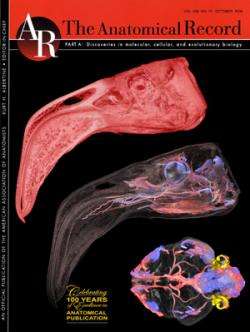Researchers Discover Evolutionary Oddity in Flamingos

With their spindly legs, long necks and bright plumage, flamingos are a curiosity of nature. Now a new discovery by a team of Ohio University researchers reveals an anatomical oddity that helps flamingos eat: erectile tissue.
Flamingos are known for their peculiar feeding behavior. While standing in shallow water, they bend their necks, tilt their bills upside down in the water and swish their heads from side-to-side. Their large tongue acts like a piston, sucking water into the front of the bill and then pushing it out the sides. Fringed plates on the tongue trap algae and crustaceans in the circulating water.
“The flamingos’ feeding habits have captured people’s curiosity for ages, but that wasn’t the original focus of our research,” said Casey Holliday, who recently earned a doctorate in biological sciences from Ohio University and served as lead author on the study. “We were investigating the evolution of jaw muscles in lizards, birds and dinosaurs. By sheer luck we discovered something new about flamingos.”
To get a detailed look at the flamingo’s jaw muscle structure, the researchers injected a colored barium/latex mixture into the blood vessels of a bird that had died and was donated by the Brevard Zoo in Florida.
A 3-D view of the bird’s head was created using a new computed tomography (CT) scanning technique developed by the Ohio University team that highlights blood vessel anatomy. The researchers noticed large oval masses of erectile tissue located on the floor of the mouth on either side of the tongue.
“No one ever anticipated finding something like this, and now we’re scratching our heads trying to understand the role these tissues play,” said Lawrence Witmer, a professor of anatomy in Ohio University’s College of Osteopathic Medicine who directed the study.
The researchers know that when the erectile tissues fill with blood, they stiffen, strengthening and supporting the floor of the mouth. “We suspect this stabilizes the mouth and tongue and helps with the peculiar way that flamingos eat,” he said. “It’s an important new piece of the puzzle of flamingo feeding—frankly, a piece we hadn’t known was missing!”
The Anatomical Record published the research findings in October and featured the study on the cover. Witmer, Ryan Ridgely and Amy Balanoff were co-authors of the study, which was funded by the National Science Foundation and conducted with the assistance of the University of Texas’ High Resolution X-Ray CT Facility.
Source: Ohio University















